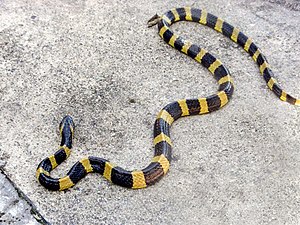Yellow-banded krait
| Yellow-banded krait | ||||||||||||
|---|---|---|---|---|---|---|---|---|---|---|---|---|

Yellow-banded krait ( Bungarus fasciatus ) |
||||||||||||
| Systematics | ||||||||||||
|
||||||||||||
| Scientific name | ||||||||||||
| Bungarus fasciatus | ||||||||||||
| ( Schneider , 1801) |
The Gelbgebänderte Krait ( Bungarus fasciatus ) is a poisonous snake and counts within the family of poisonous snakes to the genus Kraits . The species was described in 1801 by the German scientist Johann Gottlob Theaenus Schneider .
Distribution area
The distribution area of the yellow-banded krait extends from Nepal and Bhutan via Bangladesh , northeast India , Myanmar , Thailand , Laos , Cambodia , Vietnam , southern China, the Malay Peninsula , Singapore, Sumatra and Borneo to Java .
features
Male yellow-banded krait can reach a total length of 2.25 meters, but are usually smaller. Females are usually smaller than males. The body is triangular in cross section. There are 15 rows of scales on the back, the number of ventral scales is 200 to 234, that of the subcaudalia , which is always undivided, is 23 to 41. The anal scales are also undivided. There is a pre- ocular in front of the eye, and two post-ocularia behind it. Seven upper lip shields lie along the upper edge of the mouth opening, the third and fourth touching the eye and the sixth being the largest.
The snake is patterned with alternating black and yellow ribbons of the same width, the drawing extends to the belly side, which is, however, lighter overall with light yellow and gray-black ribbon sections. The head and top of the neck are black, the lip scales and throat are yellow.
Like all Venomari has Bungarus fasciatus to venom glands reformed salivary glands , which via a channel with poison in the front upper jaw located, non-movable fangs are connected (proteroglyphe tooth position).
Habitat and way of life
The yellow-banded krait lives mainly in flat and hilly areas, more rarely in the mountains up to an altitude of 2300 meters. It occurs mainly in open terrain, in fields, in grasslands, in sparse forests and their edges and rarely in swamps and river deltas. The species avoids sunlight. Exposed to sunlight, she always tries to escape into the dark or she hides her head under her entwined body. During the day she is lazy to bite, but very dangerous at night. It feeds on other snakes (ophiophagy), and it also eats fish, frogs and lizards. The females lay 5 to 15 eggs per clutch. The newly hatched young snakes are 25 to 35 cm in length.
literature
- Ulrich Manthey, Wolfgang Grossmann: Amphibians & Reptiles of Southeast Asia. Natur und Tier Verlag (1997), ISBN 978-3931587123 , pages 417-418.
Web links
- Bungarus fasciatus in The Reptile Database
- IUCN Red List: Bungarus fasciatus (accessed September 23, 2016)